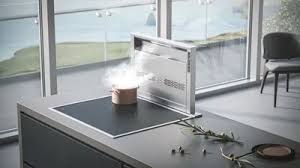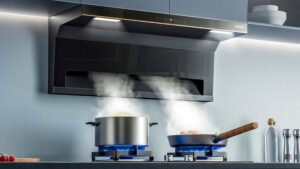If you’ve ever dreamed of a cleaner, fresher kitchen but don’t have the option to vent outside, you’ve probably wondered — are ductless range hoods effective? On the surface, they seem like the perfect solution: no complicated installation, no messy ductwork, and the freedom to place your stove almost anywhere.
But do they really get the job done when it comes to removing smoke, grease, and odors? The truth is, ductless range hoods can be incredibly convenient, but their effectiveness depends on how they’re used, maintained, and the type of cooking you do.
Before you invest in one, it’s worth understanding how they work — and where they shine (or fall short) compared to traditional vented models.
Are ductless range hoods effective?

Ductless range hoods are quite effective at trapping grease and reducing cooking odors, especially when equipped with high-quality filters and maintained regularly. The charcoal filters help neutralize odors, while the grease filters prevent buildup on kitchen surfaces.
However, their ability to remove smoke, heat, and moisture is limited compared to ducted hoods. This is because the air is simply recirculated rather than fully expelled outside.
Also, effectiveness depends heavily on a few factors: the hood’s size and airflow capacity (measured in CFM), the type and quality of filters, and how often the filters are cleaned or replaced. For light to moderate cooking, such as frying or sautéing, ductless hoods can perform well.
In addition, ductless range hoods can be effective for maintaining a cleaner kitchen and reducing odors, but their ability to remove smoke and moisture is limited. They work best for smaller kitchens, moderate cooking, and situations where venting outside isn’t possible, provided the filters are high-quality and properly maintained.
How Ductless Range Hoods Work
Ductless range hoods, also known as recirculating hoods, are kitchen appliances designed to clean the air without venting it outside. Unlike traditional ducted hoods, which expel smoke, grease, and odors outdoors, ductless hoods rely entirely on a combination of fans and filters to trap contaminants and return cleaner air back into the kitchen.
They are particularly useful in apartments, condos, or homes where installing ductwork is difficult or impossible.
- Air Intake and Capture:
When you cook, the hood’s fan draws in smoke, steam, grease particles, and odors from the stovetop. The efficiency of this step depends on the fan’s speed and design. Many hoods offer multiple fan settings, allowing you to adjust the airflow depending on whether you’re frying, boiling, or simmering. - Grease Filtration:
The first stage of filtration is usually a metal or mesh grease filter. These filters trap oil and grease droplets from cooking fumes, preventing them from recirculating into the kitchen or accumulating inside the hood’s components. Most grease filters are washable, allowing repeated use, but they must be cleaned regularly to maintain efficiency. - Odor and Smoke Filtration:
After grease is captured, the air passes through a charcoal or activated carbon filter. This layer is essential because it absorbs smoke and neutralizes odors. Over time, these filters lose effectiveness and need replacement to ensure the air remains fresh. Unlike ducted hoods, the charcoal filter is what enables a ductless hood to “clean” the air rather than simply move it outside. - Air Recirculation:
Once filtered, the cleaned air is returned to the kitchen. This recirculation system keeps kitchens smoke-free and minimizes lingering cooking odors. However, because the air isn’t vented outdoors, ductless hoods do not remove excess heat or humidity from cooking, which is an important consideration for some households. - Maintenance and Longevity:
The performance of a ductless range hood heavily relies on regular maintenance. Grease filters should be cleaned every few weeks, and charcoal filters should be replaced according to the manufacturer’s guidelines, usually every 3–6 months. Neglecting this maintenance reduces the hood’s ability to capture smoke and odors effectively.
Ductless range hoods provide a flexible, space-friendly solution for maintaining cleaner kitchen air where venting isn’t an option. With proper use and regular maintenance, they efficiently trap grease and neutralize odors, keeping your cooking environment more pleasant even without an external vent.
Factors Affecting Effectiveness
The performance of a ductless range hood depends on several key factors. While these hoods are convenient for spaces without ductwork, their ability to remove smoke, odors, and grease can vary depending on design, usage, and maintenance.
- Fan Power (CFM Rating):
The strength of the fan, measured in cubic feet per minute (CFM), determines how much air the hood can pull in. A higher CFM rating means stronger airflow, which improves the hood’s ability to capture smoke and cooking odors quickly. Low-powered fans may struggle with heavy frying or grilling, leaving lingering smells in the kitchen. - Filter Quality and Type:
The effectiveness of grease and odor removal largely depends on the type and quality of filters. Metal or mesh filters capture grease, while charcoal or activated carbon filters neutralize odors. Thicker, high-quality filters trap more particles and last longer before needing replacement. - Filter Maintenance:
Even the best filters lose efficiency if they are clogged with grease or saturated with odors. Regular cleaning of metal filters and timely replacement of carbon filters is critical for consistent performance. Neglecting this reduces airflow and allows odors and smoke to linger. - Hood Size and Coverage Area:
A hood must be wide enough to cover the cooking surface effectively. If the hood is too small or mounted too high, it won’t capture all the smoke or steam, reducing its efficiency. Ideally, the hood should extend slightly beyond the stove burners. - Cooking Habits:
The type of cooking also affects performance. Frying, grilling, or cooking aromatic foods produces more smoke and odors than boiling or simmering. Hood effectiveness can be limited if used at low fan settings during heavy cooking. - Installation Height:
Positioning the hood at the correct height above the cooktop is important. Too high, and the airflow weakens; too low, and it can interfere with cooking. Most manufacturers recommend a height between 24–30 inches for optimal performance. - Kitchen Ventilation:
While ductless hoods recirculate air, overall kitchen ventilation impacts effectiveness. In small, enclosed kitchens, air may feel stagnant, and odors can linger longer. Complementing a ductless hood with open windows or a ceiling fan can help.
The effectiveness of ductless range hoods isn’t solely determined by the appliance itself. Fan strength, filter quality, maintenance, hood size, and cooking habits all play a role in how well it keeps your kitchen air clean and fresh.
Advantages of Ductless Range Hoods

Ductless range hoods are an excellent solution for kitchens where venting air outside is difficult or impossible. Instead of exhausting air, they filter it through grease and charcoal filters, then recirculate it back into the kitchen. While they don’t remove heat or moisture as effectively as ducted hoods, they offer several practical advantages that make them highly useful in the right situations.
Advantages of Ductless Range Hoods:
- Easy Installation:
Ductless hoods don’t require external venting, meaning there’s no need to cut holes in walls or ceilings. This makes installation faster, simpler, and less expensive than ducted systems. Even renters can install them with minimal modifications, making them highly accessible. - Flexibility in Placement:
Since they don’t rely on ducts, these hoods can be installed almost anywhere in the kitchen—above a wall-mounted stove, an island, or even in compact corners. This gives homeowners more freedom in kitchen design without compromising on functionality. - Odor Reduction:
One of the main benefits is the charcoal (carbon) filter, which neutralizes cooking smells effectively. While strong smoke may linger slightly, regular filter maintenance ensures your kitchen smells fresher even after frying, sautéing, or grilling. - Grease Control:
Metal or mesh filters trap airborne grease particles before they settle on kitchen surfaces. This helps reduce the buildup on cabinets, walls, and counters, keeping the kitchen cleaner and easier to maintain over time. - Energy Efficiency:
Ductless systems recirculate the air instead of pushing heated or cooled air outside. This can reduce energy loss, especially in climates where venting hot air outside in winter or cool air in summer would increase heating or cooling costs. - Lower Maintenance Costs:
While filters need regular cleaning or replacement, ductless hoods generally require less maintenance than full ducted systems. There’s no risk of clogged ducts or leaks in vent pipes, which can be costly to repair. - Quiet Operation:
Many ductless hoods operate more quietly than ducted ones because they don’t have to push air through long duct runs. This makes for a more pleasant cooking experience. - Ideal for Small Kitchens or Apartments:
In spaces where ducting isn’t feasible due to building codes or structure, ductless hoods offer a practical alternative without compromising the basic functions of odor and grease control.
Ductless range hoods combine convenience, flexibility, and efficiency, making them an excellent choice for kitchens where traditional ducted systems aren’t practical. With proper filter maintenance, they keep your kitchen cleaner, reduce odors, and fit almost any space.
Limitations of Ductless Range Hoods
While ductless range hoods are convenient and flexible, they do have some limitations compared to traditional ducted hoods. Understanding these drawbacks helps you decide whether they fit your kitchen needs.
Limitations of Ductless Range Hoods:
- Limited Smoke and Steam Removal:
Ductless hoods recirculate air rather than venting it outside. This means they can struggle to remove heavy smoke, steam, or cooking heat efficiently. In kitchens where you do a lot of frying, grilling, or high-heat cooking, smoke may linger longer. - Dependent on Filter Quality:
The effectiveness of a ductless hood largely depends on the charcoal and grease filters. Low-quality or clogged filters reduce performance, and odors or grease may remain in the kitchen. Regular cleaning and timely replacement are essential. - Cannot Remove Heat:
Unlike ducted hoods, ductless systems don’t expel hot air. This can make the kitchen feel warmer during cooking, especially in smaller spaces or hot climates. - Higher Maintenance for Filters:
Although they avoid duct maintenance, ductless hoods require frequent filter cleaning or replacement. Charcoal filters, in particular, have a limited lifespan and can be costly over time. - Less Effective for Large Kitchens:
In very large kitchens or open-plan spaces, ductless hoods may struggle to capture all smoke, odors, and grease, making them less efficient than vented systems in heavy-use scenarios. - Noise Levels Can Be Higher at Maximum Power:
Some models need to run at higher fan speeds to handle strong odors or smoke, which can increase noise, especially during prolonged cooking sessions. - Cannot Fully Eliminate Strong Odors:
While charcoal filters reduce smells, strong or lingering odors from frying fish, spices, or smoky foods may not be completely removed.
Ductless range hoods are convenient and versatile, but they have clear limitations in smoke, heat, and odor removal. They work best in small to medium kitchens with moderate cooking, and their performance depends heavily on proper filter care.
Situations Where They Work Best
Ductless range hoods are a convenient solution, but their effectiveness depends on the kitchen layout, cooking style, and overall ventilation needs. They are best suited for specific situations where venting air outside is difficult or unnecessary.
Situations Where Ductless Range Hoods Work Best:
- Apartments and Rental Homes:
Many apartments don’t allow modifications like cutting holes in walls or ceilings. Ductless hoods are perfect because they don’t require external venting, making them easy to install without permanent changes. - Kitchens with Limited Space:
Small or compact kitchens often don’t have the room for ductwork. Ductless hoods fit neatly above stoves or cooktops, providing ventilation without taking up extra space. - Moderate Cooking Styles:
If your cooking mostly involves boiling, steaming, or light frying, ductless hoods are sufficient to reduce odors and capture grease. They’re ideal for everyday cooking that doesn’t produce heavy smoke or intense heat. - Open-Plan Kitchens with Minimal Smoke:
In homes where cooking produces mild odors or minimal smoke, ductless hoods can maintain air quality effectively without the complexity of ducted ventilation. - Temporary or Secondary Kitchens:
For outdoor kitchens, guest houses, or secondary cooking areas, ductless hoods provide quick ventilation without the cost and effort of installing ducts. - Kitchens in Buildings with Structural Limitations:
If your kitchen walls or ceilings cannot accommodate ducting due to plumbing, electrical wiring, or structural issues, a ductless hood is a practical alternative. - Budget-Conscious Homeowners:
Since they’re easier to install and don’t require ductwork, ductless hoods are often more affordable upfront, making them suitable for those looking for a simple ventilation solution without major renovation costs.
Ductless range hoods work best in small to medium kitchens, apartments, or spaces where installing ducts is impractical. They’re ideal for moderate cooking, maintaining a cleaner kitchen, and providing flexible, cost-effective ventilation solutions.
Maintenance Tips to Boost Effectiveness

Ductless range hoods rely on filters to clean and recirculate air, so proper maintenance is crucial to keep them effective. Neglecting filter care or routine cleaning can reduce performance and allow odors, grease, and smoke to linger in your kitchen.
Maintenance Tips to Boost Effectiveness:
- Clean Grease Filters Regularly:
Most ductless hoods have metal or mesh grease filters that trap oil and food particles. Remove and wash these filters every 1–2 months, depending on how often you cook. Warm soapy water or dishwasher-safe cleaning helps maintain airflow and prevents buildup. - Replace Charcoal (Carbon) Filters on Schedule:
Charcoal filters neutralize odors but lose effectiveness over time. Replace them every 3–6 months, or as recommended by the manufacturer, especially if you cook frequently or fry foods with strong smells. - Wipe Down the Hood Exterior:
Grease and dust can accumulate on the hood’s surface, affecting appearance and performance. Use a soft cloth and mild detergent to clean the exterior regularly. Avoid harsh chemicals that could damage the finish. - Check Fan and Motor Function:
Dust and grease can accumulate around the fan or motor, reducing efficiency and causing noise. Inspect these components periodically and clean them gently if needed. - Avoid Overloading the Filters:
Heavy smoke or cooking at very high heat may saturate filters quickly. Run the hood on higher settings during intense cooking and avoid prolonged exposure to smoke-heavy tasks without a break. - Follow Manufacturer Instructions:
Each hood model may have specific maintenance guidelines. Following the instructions for filter replacement, cleaning methods, and fan use ensures your hood works optimally and lasts longer. - Keep the Surrounding Kitchen Clean:
Regularly wiping counters, walls, and stovetops reduces the amount of grease and particles entering the hood, making the filters more effective and easier to maintain.
Regular cleaning, timely filter replacement, and proper use are key to boosting the effectiveness of a ductless range hood. With consistent care, these hoods can maintain fresh air, control odors, and keep your kitchen cleaner for years.
Conclusion
While there are many factors to consider when choosing kitchen ventilation, the question of Are ductless range hoods effective? often comes to mind as homeowners weigh convenience, installation, and maintenance. Ultimately, understanding their role, limitations, and best-use scenarios helps in making an informed decision that suits individual kitchen needs.

